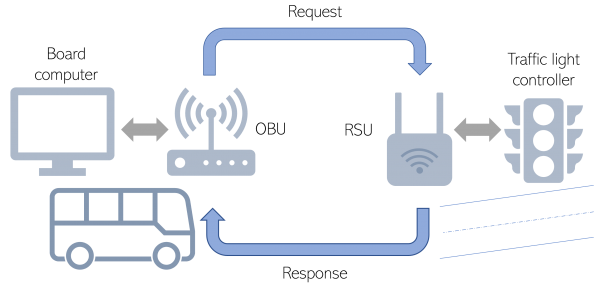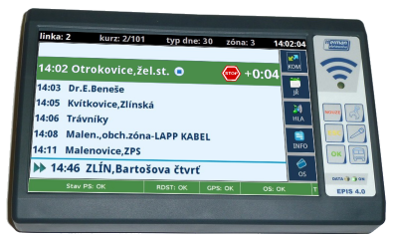Priority of public transport vehicles
Public transport vehicles pass intersections faster. Public transport operator saves money on fuel. Emissions are reduced and public transport becomes more attractive.
V2X for public transport priority
Prioritization of public transport vehicles on intersections has been already used in several cities in some of them it creates a necessary part of the public transport operation. What benefits brings V2X to this field?
Benefits of public transport priority in general
- Time savings in travel from origin to terminus (up to 15%).
- Easier keeping of the schedule – delayed vehicle gets priority at intersection.
- Emission savings as the vehicle does not have to stop several times before passing the intersection (mainly CO2 and NOx).
- Fuel consumption reduction by reduced number of stops on red.
- Higher attractivity of public transport for people.
What improvements V2X brings?
- V2X is a universal technology, of which priority is only a small part.
- The same system works for priority of other special vehicles (emergency, delivery).
- Active cooperation between vehicle and traffic light controller is inherent part of priority using V2X.
- Better information about the public transport vehicle allows the traffic light controller to provide better control.
- Secured communication – each message is signed, so only authorized vehicles can request priority.
Information exchange
Public transport vehicles, be them buses, trams or trolleybuses, have to be equipped with an OBU (On board unit). Based on its configuration and data from the board computer, the OBU sends priority requests to the RSU. The RSU passes such request to the traffic light controller (TLC). The TLC processes the request and sends back via RSU status of the request. This is received by the OBU and shown to the driver at the display of the board computer.

Two ways of priority
The V2X standard currently support two ways of priority request:

- Replication of older priority requests – wrapping of R09 message into a CAM message. This only allows to send the request, possibilities of response from the RSU are limited. This is suitable only for a replacement of an existing system.
- Full request – response communication – the OBU sends a request to the RSU (so called SRM message), it replies back with a status message (SSM). A particular intersection is addressed. This is the recommended way for a new project.
As one of only a few companies in Europe, we have experience from production deployment of both approaches (see our case studies from Brno and Ludwigsburg).
Interaction with a board computer
For its correct decision, the public transport vehicle (the OBU) must tell the traffic light controller (via the RSU) how it is going to pass the intersection. That is, the controller has to know if the vehicle is going to turn left or right. How does the OBU know this?
The OBU must obtain trip-related data from the board computer. The board computer must provide information such as line number, destination number, sequence of stops at the line, delay, vehicle number, etc. Based on such data, the OBU can determine how the vehicle will pass through the intersection and, as a result, can generate a correct request.
Cooperation with the traffic light controller
To maximize the benefits of the V2X communication, our solution uses a coordinated waiting at a stop. What does this mean? After the vehicle arrives at a stop, the driver is requested to wait in the stop until the traffic light controller is ready to give priority. As soon as the traffic light controller is ready, it signals this using a V2X message to the vehicle. The driver can see a green stripe indicating he/she should close the door and leave.
Thus, instead of waiting in the queue of cars, the bus or tram waits at the stop and can take more passengers. In addition, after it is requested to leave the stop, it passes without stopping. This way we save money of the operator and at the same make the public transport more ecological and convenient to passengers.

Protocols with the board computer
It follows that the OBU must implement a protocol with the board computer. There are many such protocols and several of them are satisfy public transport priority requirements. Some of the protocols, which our OBU supports out of the box, are:
- IBIS
- IBIS-IP (VDV 301-2)
- IBIS Plus (by Trapeze)
- Herman proprietary protocol

Complete solution for public transport priority
As a European market leader in the field, Herman elektronika can offer its customers:
- A complete solution ranging from the board computers and OBUs to RSUs and traffic light controllers (in cooperation with the company Cross).
- OBU units able to connect to almost any board computer – our reference projects prove successful communication with board computers of different marks.
- RSU units which can replicate older priority systems to enable a smooth transition phase between old system and V2X.